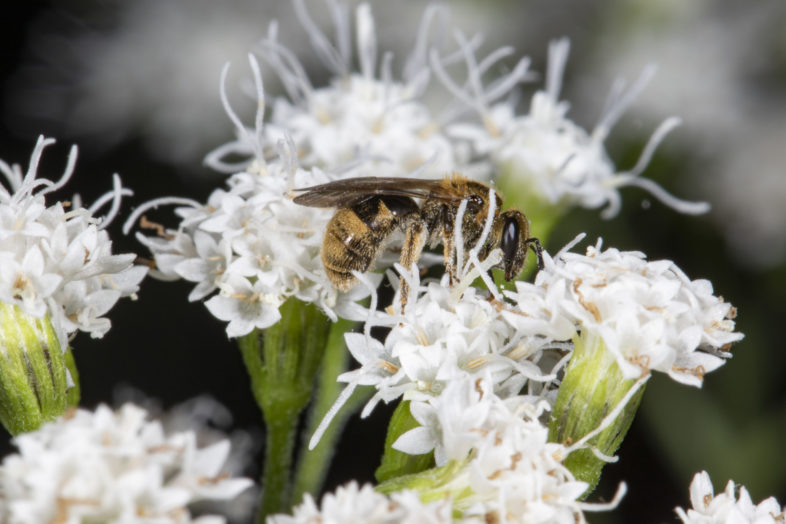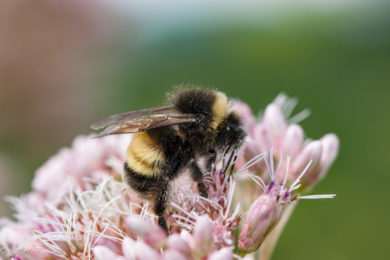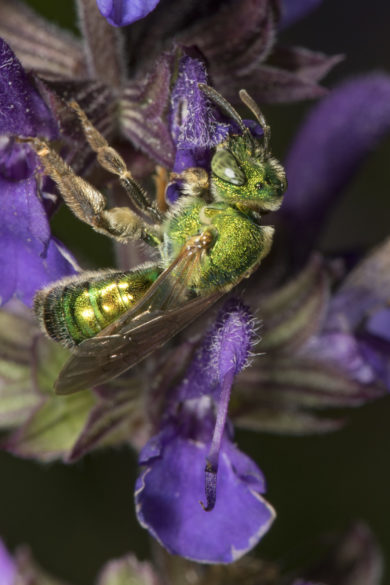Nearly 90% of flowering plants, including 75% of agricultural crops, benefit from animal pollination. The United States alone grows more than 100 crops that either need or benefit from bee pollination, and the economic value of these native pollinators is estimated at $3 billion per year.
Bees are intimately tied to flowers by their use of pollen as a protein source, making them the most important pollinator taxon in many regions. Ongoing threats to managed, non-native Western Honey Bees (Apis mellifera) have raised public awareness of the importance of bees to human wellbeing, and there is concern that some of the approximately 4,000 bee species in the United States may also be declining.
Although we estimate there are over 300 species of wild bees known from Vermont, there has never been a full survey of the State’s bees. Without even a checklist of species, it is very difficult to know whether populations of Vermont’s bees are healthy or declining. The Vermont Wild Bee Survey represents the first step in assessing bee populations across Vermont.
Most studies have focused on bumble bees and there is evidence of bumble bee declines worldwide, including in China, Europe, and North and South America. Several studies have documented declines of North American bumble bee species, and a recent assessment by the International Union for the Conservation of Nature found that 26% are vulnerable or endangered, with an additional 20% found to be ‘data deficient’. Members of the bumble bee subgenera Bombus sensu stricto and Psithyrus are particularly threatened, with endangered status protection for some in the U.S. and Canada.
Vermont Bumble Bee Atlas Results
Closer to home, we completed the Vermont Bumble Bee Atlas, a project of VCE’s Vermont Atlas of Life, from 2012 to 2014 with help from over 50 trained citizen scientists searching the entire state, amassing a database exceeding 10,000 bumble bee records from all of Vermont’s counties and biophysical regions, and 81% of the state’s 255 municipalities. To compare current bumble bee diversity and distribution in Vermont to historic records, we assembled a database of over 2,000 bumble bee records, some from as early as 1915, from 13 public and private insect collections.
Of 17 bumble bee species known from Vermont, four were not detected at all and four showed significant declines. Declining species broadly accorded with those reported elsewhere in eastern North America, and included those in subgenera Bombus, Fervidobombus, and Psithyrus. Three species were listed as Threatened or Endangered in Vermont and one was listed Federally as a result of our work. While we cannot pinpoint what may have caused these sudden bumble bee population declines, habitat loss, pathogens and parasites, pesticides, and climate change have all been implicated by recent bee studies in North America.
But not all bumble bees have fared poorly. We found that the five species that increased the most belonged to the dominant subgenus in North America called Pyrobombus, which is relatively stable or increasing in other areas of the continent as well. The Common Eastern Bumble Bee appears to be expanding its range, possibly in part due to transport of managed colonies for crop pollination.
Going Beyond Bumble Bees
Bumble bees may not be representative of the 47 other known bee genera in northeastern North America. Although we estimate there are more than 265 species of bees in Vermont, there has never been a comprehensive survey. There is evidence that some of Vermont’s native bee species are declining across their ranges, but without an inventory of the State’s bee fauna, it is very difficult to know how Vermont’s native bee species are faring. This is alarming given that recent research in the region is finding just how important native bees are to agriculture in the region. For example, scientists at UVM associated with this our new survey demonstrated that more than 90 species of wild bees visit highbush blueberry flowers on Vermont farms, contributing thousands of dollars of value to the state’s agricultural economy. And nearby in New York, Cornell scientists recently found that native bee diversity is key to better apple production.
Vermont Wild Bee Survey Phase 1 – Chittenden County
The success of the Vermont Wild Bee Survey (VTBees) depends on committed volunteers. With the help of volunteers, over the next 5 years (2019 – 2023), we’ll survey bees from the shorelines of Lake Champlain to Green Mountain Summits, boldly going where no melittologist has gone before! These new specimen records will be added to digitized historic records from museums throughout the region to build the first comprehensive survey of the bee fauna of Vermont.
In 2019, we’ll start our effort by concentrating on surveying Chittenden County. We’re hoping people like you will join VTBees, learn how to conduct surveys, and adopt a survey block. After our first successful season, we’ll expand the survey to the rest of Vermont in 2020 and beyond.
Interested in being part of this historic survey? Visit the VTBees website to learn more and sign up for the survey.
VTBees is a project of the Vermont Atlas of Life at the Vermont Center for Ecostudies in partnership with the Vermont Fish & Wildlife Department and Stone Environmental with collaboration from the University of Vermont Field Naturalist Program and the University of Vermont Gund Institute for the Environment. Financial support has been provided by a State Wildlife Grant from the Vermont Fish & Wildlife Department and generous contributions from Vermont Center for Ecostudies supporters.




I am delighted to hear about all this research and study! Am nearing the end of study with UVM’s Master Gardener Program and it’s been all about bees in this week’s module. We are doing as much as possible on our 100-acre summer property in Roxbury. Can’t wait to get up there with all my bee ID books from Pollinator Partnership, to take pics, and learn all the bees we are attracting with our native plants, including a fully dedicated garden and specially planted ‘wildflower field’, that complements our 10 acres of open meadows.
Bring on the bees! Fabulous project you are working on. Well done, Vermont!
Tatiana Govoni
Nice article.
I’m interested in working with Judy Edwards whom works at the Missisquoi Nat’l Refuge in Swanton,Vt. This is not Chittenden Co., does this matter? I told Judy I’d help her out….I live in Enosburg, Vt.!